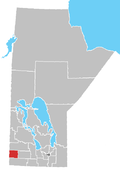| People | Dakota |
|---|---|
| Headquarters | Griswold, Manitoba R0M 0S0 |
| Government | |
| Chief | Vincent Tacan [1] |
| Tribal Council | |
| Dakota Ojibway Tribal Council | |
| Website | |
| svdngovernance | |
Sioux Valley Dakota Nation (SVDN) or Wipazoka Wakpa ('Saskatoon River', named for the abundance of Saskatoon bushes along the river) [2] is a Dakota (Sioux) First Nation that resides west of Brandon, Manitoba.
Contents
The Sioux Valley Dakota Nation has a total population of around 2,400. [3] Around 1,080 of the population resides on the Sioux Valley Dakota Nation Reserve, [4] which is located by the southeast corner of the Rural Municipality of Wallace - Woodworth.
Sioux Valley Dakota Nation comprises the Eastern Dakota bands of the Seven Council Fires. The Sisituŋwaŋ, Waȟpetuŋwaŋ, Bdewakaŋtuŋwaŋ, and Waȟpe Kute.

